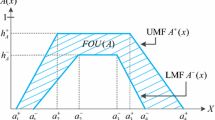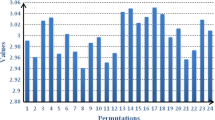Abstract
This paper develops new methods based on the preference ranking organization method for enrichment evaluations (PROMETHEE) that use a signed distance-based approach within the environment of interval type-2 fuzzy sets for multiple criteria decision analysis. The theory of interval type-2 fuzzy sets provides an intuitive and computationally feasible way of addressing uncertain and ambiguous information in decision-making fields. Many studies have developed multiple criteria decision analysis methods in the context of interval type-2 fuzzy sets; most of these methods can be characterized as scoring or compromising models. Nevertheless, the extended versions of outranking methods have not been thoroughly investigated. This paper establishes interval type-2 fuzzy PROMETHEE methods for ranking alternative actions among multiple criteria based on the concepts of signed distance-based generalized criteria and comprehensive preference indices. We develop interval type-2 fuzzy PROMETHEE I and interval type-2 fuzzy PROMETHEE II procedures for partial and complete ranking, respectively, of the alternatives. Finally, the feasibility and applicability of the proposed methods are illustrated by a practical problem of landfill site selection. A comparative analysis is also performed with ordinary fuzzy PROMETHEE methods to validate the effectiveness of the proposed methodology.





Similar content being viewed by others
References
Abbasbandy S, Asady B (2006) Ranking of fuzzy numbers by sign distance. Inf Sci 176(16):2405–2416
Abedi M, Torabi SA, Norouzi G-H, Hamzeh M, Elyasi G-R (2012) PROMETHEE II: a knowledge-driven method for copper exploration. Comput Geosci 46:255–263
Acampora G, Lee C-S, Vitiello A, Wang M-H (2012) Evaluating cardiac health through semantic soft computing techniques. Soft Comput 16(7):1165–1181
Aisbett J, Rickard JT, Morgenthaler DG (2010) Type-2 fuzzy sets as functions on spaces. IEEE Trans Fuzzy Syst 18(4):841–844
Baležentis T, Zeng S (2013) Group multi-criteria decision making based upon interval-valued fuzzy numbers: an extension of the MULTIMOORA method. Expert Syst Appl 40(2):543–550
Behzadian M, Kazemzadeh RB, Albadvi A, Aghdasi M (2010) PROMETHEE: a comprehensive literature review on methodologies and applications. Eur J Oper Res 200(1):198–215
Brans JP (1982) L’ingenierie de la decision; Elaboration d’instruments d’aide a la decision. La methode PROMETHEE. In: Nadeau R, Landry M (eds) L’aide a la decision: Nature, Instruments et Perspectives d’Avenir. Presses de l’Universite Laval, Quebec, Canada, pp 183–213
Brans JP, Mareschal B (1992) Promethee-V—MCDM problems with segmentation constraints. INFOR 30(2):85–96
Brans JP, Mareschal B (1994) The PROMETHEE-GAIA decision support system for multicriteria investigations. Invest Oper 4(2):107–117
Brans JP, Mareschal B (1995) The PROMETHEE VI procedure. How to differentiate hard from soft multicriteria problems. J Decis Syst 4:213–223
Brans JP, Mareschal B (2005) PROMETHEE methods. In: Figueira J, Greco S, Ehrgott M (eds) Multiple criteria decision analysis: state of the art surveys. Springer Science + Business Media, Inc., Boston, pp 163–195
Brans JP, Mareschal B, Vincke Ph (1984) PROMETHEE: a new family of outranking methods in multicriteria analysis. In: Brans JP (ed) Operational research ’84. North-Holland, Amsterdam, pp 477–490
Brans JP, Vincke Ph (1985) A preference ranking organization method (the PROMETHEE method for multiple criteria decision making). Manage Sci 31(6):647–656
Brans JP, Vincke Ph, Mareschal B (1986) How to select and how to rank projects: the PROMETHEE method. Eur J Oper Res 24(2):228–238
Cacioppo JT, Gardner WL, Berntson GG (1997) Beyond bipolar conceptualizations and measures: the case of attitudes and evaluative space. Person Soc Psychol Rev 1(1):3–25
Chen SM (1988) A new approach to handling fuzzy decision making problems. IEEE Trans Syst Man Cybern 18(6):1012–1016
Chen SM (1996) New methods for subjective mental workload assessment and fuzzy risk analysis. Cybern Syst 27(5):449–472
Chen T-Y (2011a) Signed distanced-based TOPSIS method for multiple criteria decision analysis based on generalized interval-valued fuzzy numbers. Int J Inf Technol Decis Making 10(6):1131–1159
Chen T-Y (2011b) An integrated approach for assessing criterion importance with interval type-2 fuzzy sets and signed distances. J Chin Inst Ind Eng 28(8):553–572
Chen T-Y (2012a) Multiple criteria group decision-making with generalized interval-valued fuzzy numbers based on signed distances and incomplete weights. Appl Math Model 36(7):3029–3052
Chen T-Y (2012b) Collaborative decision-making method for patient-centered care based on interval type-2 fuzzy sets. J Chin Inst Ind Eng 29(7):494–513
Chen T-Y, Chang C-H, Lu JfR (2013) The extended QUALIFLEX method for multiple criteria decision analysis based on interval type-2 fuzzy sets and applications to medical decision making. Eur J Oper Res 226(3):615–625
Chen S-M, Chen J-H (2009) Fuzzy risk analysis based on similarity measures between interval-valued fuzzy numbers and interval-valued fuzzy number arithmetic operators. Expert Syst Appl 36(3–2):6309–6317
Chen S-M, Lee L-W (2010a) Fuzzy multiple attributes group decision-making based on the ranking values and the arithmetic operations of interval type-2 fuzzy sets. Expert Syst Appl 37(1):824–833
Chen S-M, Lee L-W (2010b) Fuzzy multiple criteria hierarchical group decision-making based on interval type-2 fuzzy sets. IEEE Trans Syst Man Cybern Part A Syst Hum 40(5):1120–1128
Chen L-H, Ouyang L-Y (2006) Fuzzy inventory model for deteriorating items with permissible delay in payment. Appl Math Comput 182(1):711–726
Chen Y-H, Wang T-C, Wu C-Y (2011) Strategic decisions using the fuzzy PROMETHEE for IS outsourcing. Expert Syst Appl 38(10):13216–13222
Chen S-M, Yang M-W, Lee L-W, Yang S-W (2012) Fuzzy multiple attributes group decision-making based on ranking interval type-2 fuzzy sets. Expert Syst Appl 39(5):5295–5308
Chernev A (2004) Goal orientation and consumer preference for the status quo. J Consum Res 31(3):557–565
Chiang J (2001) Fuzzy linear programming based on statistical confidence interval and interval-valued fuzzy set. Eur J Oper Res 129(1):65–86
Das S, Chowdhury SR, Saha H (2012) Accuracy enhancement in a fuzzy expert decision making system through appropriate determination of membership functions and its application in a medical diagnostic decision making system. J Med Syst 36(3):1607–1620
Fernandez-Castro AS, Jimenez M (2005) PROMETHEE: an extension through fuzzy mathematical programming. J Oper Res Soc 56(1):119–122
Figueira J, de Smet Y, Brans JP (2004) MCDA methods for sorting and clustering problems: Promethee TRI and Promethee CLUSTER, Universite Libre de Bruxelles. Service deMathematiques de la Gestion, Working Paper 2004/02. http://www.ulb.ac.be/polytech/smg/indexpublications.htm
Gilan SS, Sebt MH, Shahhosseini V (2012) Computing with words for hierarchical competency based selection of personnel in construction companies. Appl Soft Comput 12(2):860–871
Grabisch M, Greco S, Pirlot M (2008) Bipolar and bivariate models in multicriteria decision analysis: descriptive and constructive approaches. Int J Intell Syst 23(9):930–969
Han S, Mendel JM (2012) A new method for managing the uncertainties in evaluating multi-person multi-criteria location choices, using a perceptual computer. Ann Oper Res 195(1):277–309
Hatami-Marbini A, Tavana M (2011) An extension of the Electre I method for group decision-making under a fuzzy environment. Omega 39(4):373–386
Hosseini MB, Tarokh MJ (2011) Interval type-2 fuzzy set extension of DEMATEL method. In: Das VV, Thankachan N (eds) Communications in computer and information science 250 CIIT 2011. Springer, Berlin, pp 157–165
Hsu T-H, Lin L-Z (2012) Using fuzzy preference method for group package tour based on the risk perception. Group Decis Negotiat. doi:10.1007/s10726-012-9313-7
Kadziński M, Greco S, Słowiński R (2012) Extreme ranking analysis in robust ordinal regression. Omega 40(4):488–501
Macharis C, Brans JP, Mareschal B (1998) The GDSS PROMETHEE procedure—a PROMETHEE-GAIA based procedure for group decision support. J Decis Syst 7:283–307
Mareschal B, Brans JP (1988) Geometrical representations for MCDA. The GAIA module. Eur J Oper Res 34(1):69–77
Li WX, Li BY (2010) An extension of the PROMETHEE II method based on generalized fuzzy numbers. Expert Syst Appl 37(7):5314–5319
Peng Y, Wang G, Kou G, Shi Y (2011) An empirical study of classification algorithm evaluation for financial risk prediction. Appl Soft Comput 11(2):2906–2915
Pham MT, Avnet T (2004) Ideals and oughts and the reliance of affect versus substance in persuasion. J Consum Res 30(4):503–518
Rajpathak D, Chougule R, Bandyopadhyay P (2012) A domain-specific decision support system for knowledge discovery using association and text mining. Knowl Inf Syst 31(3):405–432
Su ZX (2011) A hybrid fuzzy approach to fuzzy multi-attribute group decision-making. Int J Inf Technol Decis Making 10(4):695–711
Suo W-L, Feng B, Fan Z-P (2012) Extension of the DEMATEL method in an uncertain linguistic environment. Soft Comput 16(3):471–483
Taha Z, Rostam S (2012) A hybrid fuzzy AHP-PROMETHEE decision support system for machine tool selection in flexible manufacturing cell. J Intell Manuf 23(6):2137–2149
Vinodh S, Jeya Girubha R (2012) PROMETHEE based sustainable concept selection. Appl Math Model 36(11):5301–5308
Wang W, Liu X, Qin Y (2012) Multi-attribute group decision making models under interval type-2 fuzzy environment. Knowl Based Syst 30:121–128
Wei S-H, Chen S-M (2009) Fuzzy risk analysis based on interval-valued fuzzy numbers. Expert Syst Appl 36(2–1):2285–2299
Yao JS, Wu K (2000) Ranking fuzzy numbers based on decomposition principle and signed distance. Fuzzy Sets Syst 116(2):275–288
Yilmaz B, Dağdeviren M (2011) A combined approach for equipment selection: F-PROMETHEE method and zero-one goal programming. Expert Syst Appl 38(9):11641–11650
Zadeh LA (1975) The concept of a linguistic variable and its application to approximate reasoning—I. Inf Sci 8(3):199–249
Zhai D, Mendel JM (2011) Uncertainty measures for general Type-2 fuzzy sets. Inf Sci 181(3):503–518
Zhang K, Kluck C, Achari G (2009) A comparative approach for ranking contaminated sites based on the risk assessment paradigm using fuzzy PROMETHEE. Environ Manage 44(5):952–967
Zhang Z, Zhang S (2013) A novel approach to multi attribute group decision making based on trapezoidal interval type-2 fuzzy soft sets. Appl Math Model 37(7):4948–4971
Acknowledgments
The author is very grateful to the respected editor and the anonymous referees for their insightful and constructive comments, which helped to improve the overall quality of the paper. The author is grateful to the grant funding support of Taiwan National Science Council (NSC 102-2410-H-182-013-MY3) during which the study was completed.
Author information
Authors and Affiliations
Corresponding author
Additional information
Communicated by H. Hagras.
Appendix
Appendix
Definition 6.1
Let \(X\) be an ordinary finite nonempty set. Let Int([0, 1]) denote a set of all closed subintervals of [0, 1]. The mapping \(A\): \(X\rightarrow \) Int([0, 1]) is known as an IT2FS on \(X\). All IT2FSs on \(X\) are denoted by IT2FS\((X)\).
Definition 6.2
If \(A\in \mathrm{IT2FS}(X)\), let \(A(x)\!=\![A^{L}(x), A^{U}(x)]\), where \(x\in X\) and \(0\le A^L(x)\le A^U(x)\le 1\). The two T1FSs \(A^{L}: X\rightarrow [0, 1]\) and \(A^{U}: X\rightarrow [0, 1]\) are known as the lower and upper fuzzy sets, respectively, with respect to \(A\). If \(A(x)\) is convex and defined on a closed and bounded interval, then \(A\) is known as “an interval type-2 fuzzy number on \(X\)”.
Definition 6.3
Let \(A^L(=(a_1^L, a_2^L, a_3^L, a_4^L ;h_A^L))\) and \(A^U(=(a_1^U, a_2^U, a_3^U, a_4^U ;h_A^U))\) be the lower and upper trapezoidal fuzzy numbers defined on the universe of discourse \(X\), where \(a_1^L \le a_2^L \le a_3^L \le a_4^L \), \(a_1^U \le a_2^U \le a_3^U \le a_4^U \), \(0\le h_A^L \le h_A^U \le 1\), \(a_1^U \le a_1^L \), \(a_4^L \le a_4^U \), and \(A^L\subset A^U\). Let \(\xi \in \{L\), \(U\}\). The membership function of \(A^\xi \) for each \(\xi \) is expressed as follows:
An IT2TrFN \(A\) on \(X\) is represented by the following:
The extension principle (Zadeh 1975) can be employed to develop fuzzy arithmetic defined as IT2FSs (Aisbett et al. 2010; Gilan et al. 2012). Let \(\oplus \) denote the addition operation, and let \(A\) and \(B\) denote IT2FSs. By using Zadeh’s extension principle, we define an IT2FS for a set of all real numbers \(A\oplus B\) with the following equation:
where sup is the supremum. Based on interval-valued arithmetic, standard arithmetic operations on trapezoidal-shaped fuzzy numbers can be extended to IT2TrFNs.
Definition 6.4
Let \(A\) and \(B\) be two nonnegative IT2TrFNs. \(A=[(a_1^L, a_2^L, a_3^L, a_4^L ;h_A^L ), (a_1^U, a_2^U, a_3^U, a_4^U ;h_A^U)]\), and \(B=[(b_1^L, b_2^L , b_3^L, b_4^L ;h_B^L), (b_1^U, b_2^U, b_3^U, b_4^U ;h_B^U)]\) on \(X\). The arithmetic operations on \(A\) and \(B\) are defined as follows:
The multiplication and division operations produce approximate IT2TrFNs for simple computations.
Rights and permissions
About this article
Cite this article
Chen, TY. A PROMETHEE-based outranking method for multiple criteria decision analysis with interval type-2 fuzzy sets. Soft Comput 18, 923–940 (2014). https://doi.org/10.1007/s00500-013-1109-4
Published:
Issue Date:
DOI: https://doi.org/10.1007/s00500-013-1109-4




